TROJ_FAKEAV.SM26
Windows 2000, Windows XP, Windows Server 2003


Threat Type: Trojan
Destructiveness: No
Encrypted: Yes
In the wild: Yes
OVERVIEW
This malware randomly chooses its name from the following. It also checks the OS version and uses it in its name.
- {OS Version} Anti-Virus 2011
- {OS Version} Total Security 2011
- {OS Version} Total Security
- {OS Version} Security 2011
- {OS Version} Internet Security 2011
- {OS Version} Anti-Spyware Security 2011
- {OS Version} Anti-Spyware
- {OS Version} Home Security
- {OS Version} Home Security 2011
It opens windows in Internet Explorer and Mozilla Firefox. It briefly displays a certain web page before redirecting users to the site that they intend to visit. A window is then displayed for users to purchase the fake antivirus program.
This Trojan arrives as an attachment to email messages spammed by other malware/grayware or malicious users. It may be downloaded by other malware/grayware/spyware from remote sites. It may be unknowingly downloaded by a user while visiting malicious websites.
It displays fake alerts that warn users of infection. It also displays fake scanning results of the affected system. It then asks for users to purchase it once scanning is completed. If users decide to purchase the rogue product, users are directed to a certain website asking for sensitive information, such as credit card numbers.
TECHNICAL DETAILS
Varies
EXE
Yes
28 Apr 2011
Displays graphics/image, Opens Internet Explorer window
Arrival Details
This Trojan arrives as an attachment to email messages spammed by other malware/grayware or malicious users.
It may be downloaded by other malware/grayware/spyware from remote sites.
It may be unknowingly downloaded by a user while visiting malicious websites.
Installation
This Trojan drops the following non-malicious files:
- %Application Data%\{random characters}
(Note: %Application Data% is the current user's Application Data folder, which is usually C:\Documents and Settings\{user name}\Application Data on Windows 2000, XP, and Server 2003, or C:\Users\{user name}\AppData\Roaming on Windows Vista and 7.)
Other System Modifications
This Trojan adds the following registry keys:
HKEY_CLASSES_ROOT\.exe\DefaultIcon
HKEY_CLASSES_ROOT\.exe\shell
It adds the following registry entries:
HKEY_CLASSES_ROOT\.exe\DefaultIcon
(Default) = %1
HKEY_CLASSES_ROOT\.exe\shell\
open\command
(Default) = {malware path and file name} -a "%1" %*
HKEY_CLASSES_ROOT\.exe\shell\
open\command
IsolatedCommand = "%1" %*
HKEY_CLASSES_ROOT\.exe\shell\
runas\command
(Default) = "%1" %*
HKEY_CLASSES_ROOT\.exe\shell\
runas\command
IsolatedCommand = "%1" %*
HKEY_CLASSES_ROOT\exefile
Content Type = application/x-msdownload
HKEY_CLASSES_ROOT\exefile\shell\
open\command
IsolatedCommand = "%1" %*
HKEY_CLASSES_ROOT\exefile\shell\
runas\command
IsolatedCommand = "%1" %*
HKEY_CURRENT_USER\Software\Microsoft\
Windows
Identity = {random hex values}
HKEY_CURRENT_USER\Software\Microsoft\
Windows\CurrentVersion\Run
ctfmon.exe = %System%\ctfmon.exe
It modifies the following registry entries:
HKEY_LOCAL_MACHINE\SYSTEM\CurrentControlSet\
Services\SharedAccess\Parameters\
FirewallPolicy\StandardProfile
EnableFirewall = 0
(Note: The default value data of the said registry entry is 1.)
HKEY_LOCAL_MACHINE\SYSTEM\CurrentControlSet\
Services\SharedAccess\Parameters\
FirewallPolicy\StandardProfile
DoNotAllowExceptions = 0
(Note: The default value data of the said registry entry is 1.)
HKEY_LOCAL_MACHINE\SYSTEM\CurrentControlSet\
Services\SharedAccess\Parameters\
FirewallPolicy\StandardProfile
DisableNotifications = 1
(Note: The default value data of the said registry entry is 0.)
HKEY_LOCAL_MACHINE\SYSTEM\CurrentControlSet\
Services\SharedAccess\Parameters\
FirewallPolicy\DomainProfile
EnableFirewall = 0
(Note: The default value data of the said registry entry is 1.)
HKEY_LOCAL_MACHINE\SYSTEM\CurrentControlSet\
Services\SharedAccess\Parameters\
FirewallPolicy\DomainProfile
DoNotAllowExceptions = 0
(Note: The default value data of the said registry entry is 1.)
HKEY_LOCAL_MACHINE\SYSTEM\CurrentControlSet\
Services\SharedAccess\Parameters\
FirewallPolicy\DomainProfile
EnableFirewall = 0
(Note: The default value data of the said registry entry is 1.)
HKEY_LOCAL_MACHINE\SOFTWARE\Microsoft\
Security Center
AntiVirusDisableNotify = 1
(Note: The default value data of the said registry entry is 0.)
HKEY_LOCAL_MACHINE\SOFTWARE\Microsoft\
Security Center
AntiVirusOverride = 1
(Note: The default value data of the said registry entry is 0.)
HKEY_LOCAL_MACHINE\SOFTWARE\Microsoft\
Security Center
FirewallDisableNotify = 1
(Note: The default value data of the said registry entry is 0.)
HKEY_LOCAL_MACHINE\SOFTWARE\Microsoft\
Security Center
FirewallOverride = 1
(Note: The default value data of the said registry entry is 0.)
HKEY_LOCAL_MACHINE\SOFTWARE\Microsoft\
Security Center
UpdatesDisableNotify = 1
(Note: The default value data of the said registry entry is 0.)
HKEY_LOCAL_MACHINE\SOFTWARE\Clients\
StartMenuInternet\FIREFOX.EXE\shell\
open\command
(Default) = {malware path and file name} -a "%Program Files%\Mozilla Firefox\firefox.exe"
(Note: The default value data of the said registry entry is %Program Files%\Mozilla Firefox\firefox.exe.)
HKEY_LOCAL_MACHINE\SOFTWARE\Clients\
StartMenuInternet\FIREFOX.EXE\shell\
safemode\command
(Default) = {malware path and file name} -a "%Program Files%\Mozilla Firefox\firefox.exe" -safe-mode
(Note: The default value data of the said registry entry is %Program Files%\Mozilla Firefox\firefox.exe -safe-mode.)
HKEY_LOCAL_MACHINE\SOFTWARE\Clients\
StartMenuInternet\IEXPLORE.EXE\shell\
open\command
(Default) = {malware path and file name} -a "%Program Files%\Internet Explorer\iexplore.exe"
(Note: The default value data of the said registry entry is %Program Files%\Internet Explorer\iexplore.exe.)
Rogue Antivirus Routine
This Trojan displays fake alerts that warn users of infection. It also displays fake scanning results of the affected system. It then asks for users to purchase it once scanning is completed. If users decide to purchase the rogue product, users are directed to a certain website asking for sensitive information, such as credit card numbers.
NOTES:
This malware randomly chooses its name from the following. It also checks the OS version and uses it in its name.
- {OS Version} Anti-Virus 2011
- {OS Version} Total Security 2011
- {OS Version} Total Security
- {OS Version} Security 2011
- {OS Version} Internet Security 2011
- {OS Version} Anti-Spyware Security 2011
- {OS Version} Anti-Spyware
- {OS Version} Home Security
- {OS Version} Home Security 2011

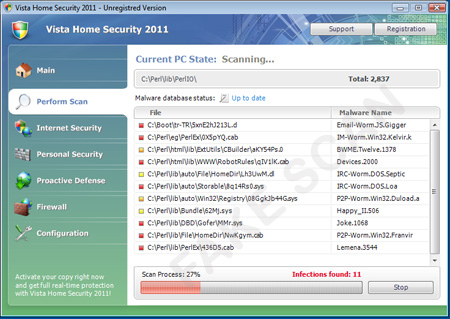
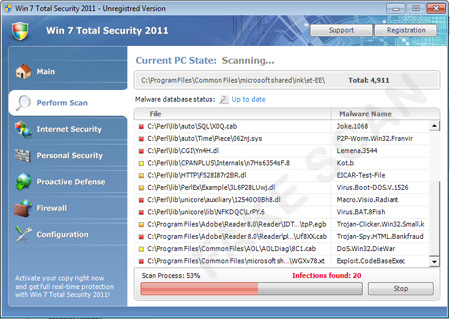

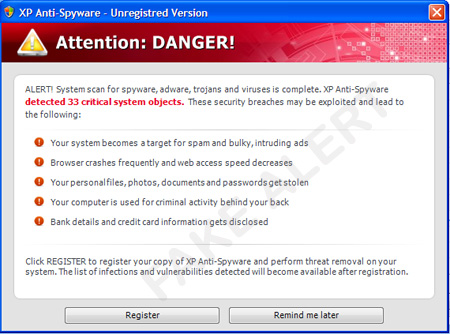
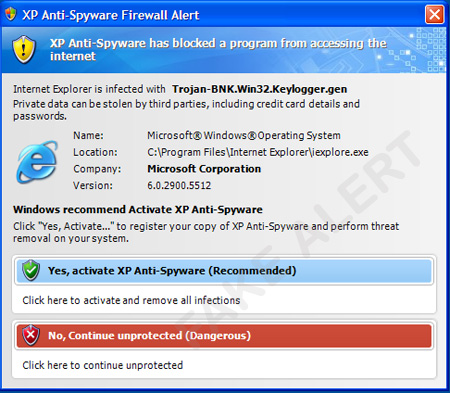

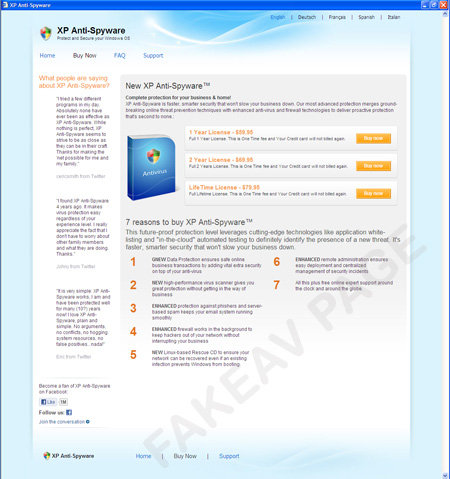
SOLUTION
8.900
8.126.10
30 Apr 2011
8.127.00
30 Apr 2011
Step 1
Before doing any scans, Windows XP, Windows Vista, and Windows 7 users must disable System Restore to allow full scanning of their computers.
Step 2
Identify and terminate files detected as TROJ_FAKEAV.SM26
- Windows Task Manager may not display all running processes. In this case, please use a third-party process viewer, preferably Process Explorer, to terminate the malware/grayware/spyware file. You may download the said tool here.
- If the detected file is displayed in either Windows Task Manager or Process Explorer but you cannot delete it, restart your computer in safe mode. To do this, refer to this link for the complete steps.
- If the detected file is not displayed in either Windows Task Manager or Process Explorer, continue doing the next steps.
Step 3
Delete this registry key
Important: Editing the Windows Registry incorrectly can lead to irreversible system malfunction. Please do this step only if you know how or you can ask assistance from your system administrator. Else, check this Microsoft article first before modifying your computer's registry.
- In HKEY_CLASSES_ROOT\.exe
- DefaultIcon
- DefaultIcon
- In HKEY_CLASSES_ROOT\.exe
- shell
- shell
Step 4
Delete this registry value
Important: Editing the Windows Registry incorrectly can lead to irreversible system malfunction. Please do this step only if you know how or you can ask assistance from your system administrator. Else, check this Microsoft article first before modifying your computer's registry.
- In HKEY_CLASSES_ROOT\exefile
- Content Type = application/x-msdownload
- Content Type = application/x-msdownload
- In HKEY_CLASSES_ROOT\exefile\shell\open\command
- IsolatedCommand = %1 %*
- IsolatedCommand = %1 %*
- In HKEY_CLASSES_ROOT\exefile\shell\runas\command
- IsolatedCommand = %1 %*
- IsolatedCommand = %1 %*
- In HKEY_CURRENT_USER\Software\Microsoft\Windows
- Identity = {random hex values}
- Identity = {random hex values}
- In HKEY_CURRENT_USER\Software\Microsoft\Windows\CurrentVersion\Run
- ctfmon.exe = %System%\ctfmon.exe
- ctfmon.exe = %System%\ctfmon.exe
Step 5
Restore this modified registry value
Important: Editing the Windows Registry incorrectly can lead to irreversible system malfunction. Please do this step only if you know how or you can ask assistance from your system administrator. Else, check this Microsoft article first before modifying your computer's registry.
- In HKEY_LOCAL_MACHINE\SYSTEM\CurrentControlSet\Services\SharedAccess\Parameters\FirewallPolicy\StandardProfile
- From: EnableFirewall = 0
To: EnableFirewall = 1
- From: EnableFirewall = 0
- In HKEY_LOCAL_MACHINE\SYSTEM\CurrentControlSet\Services\SharedAccess\Parameters\FirewallPolicy\StandardProfile
- From: DoNotAllowExceptions = 0
To: DoNotAllowExceptions = 1
- From: DoNotAllowExceptions = 0
- In HKEY_LOCAL_MACHINE\SYSTEM\CurrentControlSet\Services\SharedAccess\Parameters\FirewallPolicy\StandardProfile
- From: DisableNotifications = 1
To: DisableNotifications = 0
- From: DisableNotifications = 1
- In HKEY_LOCAL_MACHINE\SYSTEM\CurrentControlSet\Services\SharedAccess\Parameters\FirewallPolicy\DomainProfile
- From: EnableFirewall = 0
To: EnableFirewall = 1
- From: EnableFirewall = 0
- In HKEY_LOCAL_MACHINE\SYSTEM\CurrentControlSet\Services\SharedAccess\Parameters\FirewallPolicy\DomainProfile
- From: DoNotAllowExceptions = 0
To: DoNotAllowExceptions = 1
- From: DoNotAllowExceptions = 0
- In HKEY_LOCAL_MACHINE\SYSTEM\CurrentControlSet\Services\SharedAccess\Parameters\FirewallPolicy\DomainProfile
- From: EnableFirewall = 0
To: EnableFirewall = 1
- From: EnableFirewall = 0
- In HKEY_LOCAL_MACHINE\SOFTWARE\Microsoft\Security Center
- From: AntiVirusDisableNotify = 1
To: AntiVirusDisableNotify = 0
- From: AntiVirusDisableNotify = 1
- In HKEY_LOCAL_MACHINE\SOFTWARE\Microsoft\Security Center
- From: AntiVirusOverride = 1
To: AntiVirusOverride = 0
- From: AntiVirusOverride = 1
- In HKEY_LOCAL_MACHINE\SOFTWARE\Microsoft\Security Center
- From: FirewallDisableNotify = 1
To: FirewallDisableNotify = 0
- From: FirewallDisableNotify = 1
- In HKEY_LOCAL_MACHINE\SOFTWARE\Microsoft\Security Center
- From: FirewallOverride = 1
To: FirewallOverride = 0
- From: FirewallOverride = 1
- In HKEY_LOCAL_MACHINE\SOFTWARE\Microsoft\Security Center
- From: UpdatesDisableNotify = 1
To: UpdatesDisableNotify = 0
- From: UpdatesDisableNotify = 1
- In HKEY_LOCAL_MACHINE\SOFTWARE\Clients\StartMenuInternet\FIREFOX.EXE\shell\open\command
- From: (Default) = {malware path and file name} -a "%Program Files%\Mozilla Firefox\firefox.exe"
To: (Default) = %Program Files%\Mozilla Firefox\firefox.exe
- From: (Default) = {malware path and file name} -a "%Program Files%\Mozilla Firefox\firefox.exe"
- In HKEY_LOCAL_MACHINE\SOFTWARE\Clients\StartMenuInternet\FIREFOX.EXE\shell\safemode\command
- From: (Default) = {malware path and file name} -a "%Program Files%\Mozilla Firefox\firefox.exe" -safe-mode
To: (Default) = %Program Files%\Mozilla Firefox\firefox.exe -safe-mode
- From: (Default) = {malware path and file name} -a "%Program Files%\Mozilla Firefox\firefox.exe" -safe-mode
- In HKEY_LOCAL_MACHINE\SOFTWARE\Clients\StartMenuInternet\IEXPLORE.EXE\shell\open\command
- From: (Default) = {malware path and file name} -a "%Program Files%\Internet Explorer\iexplore.exe"
To: (Default) = %Program Files%\Internet Explorer\iexplore.exe
- From: (Default) = {malware path and file name} -a "%Program Files%\Internet Explorer\iexplore.exe"
Step 6
Search and delete these components
Step 7
Scan your computer with your Trend Micro product to delete files detected as TROJ_FAKEAV.SM26. If the detected files have already been cleaned, deleted, or quarantined by your Trend Micro product, no further step is required. You may opt to simply delete the quarantined files. Please check this Knowledge Base page for more information.
Did this description help? Tell us how we did.

